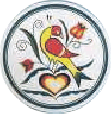Homemade Pie Crust
Makes one 9-inch single or double pie crust
This is the pie crust recipe my Pennsylvania Dutch mother and grandmother always used. The only thing that has changed through the years is the type of fat used. My grandmother used lard because it was always available back then and, if you can find it, it does make the best crust. I do not know why my mother switched to shortening, but it was a popular fat in her day, especially when butter was scarce. I prefer a combination of shortening and butter. The butter adds flavor and the shortening makes a very tender, flaky crust. To avoid the trans fats in shortening, try to get a non-hydrogenated variety. See the notes below for some other helpful suggestions.
Single Crust
- 1-1/2 cups sifted all-purpose flour
- 1/4 teaspoon salt
- 1/2 cup chilled shortening or unsalted butter, or half of each, cut into cubes
- 3 tablespoons cold water, more or less as needed
Combine flour and salt in bowl. Add shortening and/or butter and blend with fork, pastry cutter or your fingers until mixture is fairly coarse. Add water, 1 tablespoon at a time, gently mixing dough after each addition just until dough forms a ball. (Dough can also be prepared in food processor. Use the pulse button just until it starts to pull away from the sides. Be very careful not to overwork the dough.) Form dough into a thin disk. Wrap in plastic wrap and refrigerate at least 30 minutes to chill and allow the glutens in the flour to relax.
Place chilled dough on a lightly floured surface and roll into a 10 to 11 inch circle. Place it into a 9-inch pie pan. Flute edges. Chill until use.
If pie recipe calls for a prebaked pie crust, preheat oven to 425° F. Prick sides and bottom of pie shell with fork. Place pie weights, dried beans or rice on a piece of foil or parchment paper in bottom of shell to keep pastry flat while baking. Bake for 10 to 15 minutes or until crust is brown as desired. (If using beans or rice, save for another pie. They cannot be used for cooking.)
Double Crust
- 2 cups sifted all-purpose flour
- 1/2 teaspoon salt
- 3/4 cup chilled shortening or unsalted butter, or half of each, cut into cubes
- 5 tablespoons cold water, more or less as needed
Follow recipe for single crust pie, but divide dough into two portions, one slightly larger than the other. Chill as directed above. Roll out the larger portion for the bottom and line a 9-inch pie pan. Roll the top portion, place on top, crimp edges together, and cut some slits to allow steam to escape. Brush the top with an egg wash. The top portion can also be used for a lattice top.
Notes: If making crust for two pies, make the single dough twice. The double crust will not be enough. If a sweet dough is desired, add 1 teaspoon sugar to the single crust or 1-1/2 teaspoons to the double. For a savory crust, dried herbs can be added to complement the filling. One of the secrets to a tender, flaky crust is to never overwork the dough. Also, do not use too much water. My flakiest crusts are the ones that seem to fall apart as I roll them. I always chill the dough in the pan after it is rolled out, before adding the filling and baking. You can make the dough a day or two ahead of time, roll it or not, and refrigerate until use. It can also be frozen for up to three months.

No matter where I take my guests, it seems they like my kitchen best.
Pennsylvania Dutch Saying
This site may not be reproduced in whole or in part without written permission and appropriate credit given. Written, designed and maintained by Teri Ranck Foster. All rights reserved. Copyright Statement, Privacy Policy and Disclaimers.

